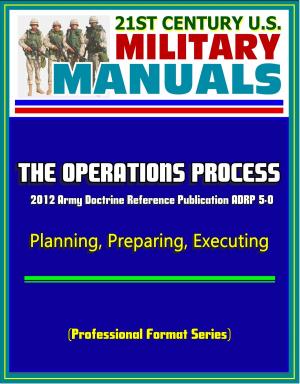Air Force Doctrine Document 3-60: Targeting - Target Characteristics, Weaponeering, Mensuration, Collateral Damage, Tasking Cycle, Campaign Assessment, Effects-Based Operations (EBO)
Nonfiction, History, Military, Aviation, Social & Cultural Studies, Political Science| Author: | Progressive Management | ISBN: | 9781476193892 |
| Publisher: | Progressive Management | Publication: | April 19, 2012 |
| Imprint: | Smashwords Edition | Language: | English |
| Author: | Progressive Management |
| ISBN: | 9781476193892 |
| Publisher: | Progressive Management |
| Publication: | April 19, 2012 |
| Imprint: | Smashwords Edition |
| Language: | English |
This Air Force Doctrine Document (AFDD) establishes doctrinal guidance for planning, executing, and assessing targeting operations.
Time and time again in the last several decades, air and space power has proven among the most powerful of weapons in the nation's military arsenal, deciding some conflicts outright and enabling us to resolve others in the manner of our choosing. Today, air and space power can impose decisive effects anywhere on the globe at almost any time, but it has taken more than this global reach to make it the world's premier military instrument. Sound doctrine, strategy, and operational art are also required and the discipline of targeting is a vital piece of Air Force operational art.
Guided by sound doctrine and strategy, targeting during conflict enables air and space power to be a decisive force in modern warfare. Targeting processes and principles that encompass the realms of information and influence can also have decisive effects upon operations other than major combat. This publication describes what targeting is and how it supports the overarching structure of air and space planning, execution, and assessment. The United States military operates according to effects-based principles, which tie planning, execution, and assessment together into an adaptive whole. Accordingly, this publication also shows why and how effects-based thinking is integral to effective targeting today. This document builds upon the foundational doctrine concepts of an effects-based approach established in Air Force Doctrine Document 2, Operations and Organization.
Targeting has been a vital part of air and space power since the first weapon was dropped from an aircraft. It has evolved over a century from a matter of primitive guesswork into a discipline based on scientific principles and robust processes that is used to guide employment of much more than just weapons dropped from airplanes. Targeting will continue to evolve as it assimilates the insights of effects-based operations, improvements in battlespace awareness, and other innovations, but it will always be central to the way the Air Force conducts operations.
Contents: Chapter One - Targeting Fundamentals * Chapter Two - Deliberate Targeting * Chapter Three - Dynamic Targeting * Chapter Four - Assessment * Chapter Five - Readiness And Ongoing Responsibilities For Targeting
This Air Force Doctrine Document (AFDD) establishes doctrinal guidance for planning, executing, and assessing targeting operations.
Time and time again in the last several decades, air and space power has proven among the most powerful of weapons in the nation's military arsenal, deciding some conflicts outright and enabling us to resolve others in the manner of our choosing. Today, air and space power can impose decisive effects anywhere on the globe at almost any time, but it has taken more than this global reach to make it the world's premier military instrument. Sound doctrine, strategy, and operational art are also required and the discipline of targeting is a vital piece of Air Force operational art.
Guided by sound doctrine and strategy, targeting during conflict enables air and space power to be a decisive force in modern warfare. Targeting processes and principles that encompass the realms of information and influence can also have decisive effects upon operations other than major combat. This publication describes what targeting is and how it supports the overarching structure of air and space planning, execution, and assessment. The United States military operates according to effects-based principles, which tie planning, execution, and assessment together into an adaptive whole. Accordingly, this publication also shows why and how effects-based thinking is integral to effective targeting today. This document builds upon the foundational doctrine concepts of an effects-based approach established in Air Force Doctrine Document 2, Operations and Organization.
Targeting has been a vital part of air and space power since the first weapon was dropped from an aircraft. It has evolved over a century from a matter of primitive guesswork into a discipline based on scientific principles and robust processes that is used to guide employment of much more than just weapons dropped from airplanes. Targeting will continue to evolve as it assimilates the insights of effects-based operations, improvements in battlespace awareness, and other innovations, but it will always be central to the way the Air Force conducts operations.
Contents: Chapter One - Targeting Fundamentals * Chapter Two - Deliberate Targeting * Chapter Three - Dynamic Targeting * Chapter Four - Assessment * Chapter Five - Readiness And Ongoing Responsibilities For Targeting















